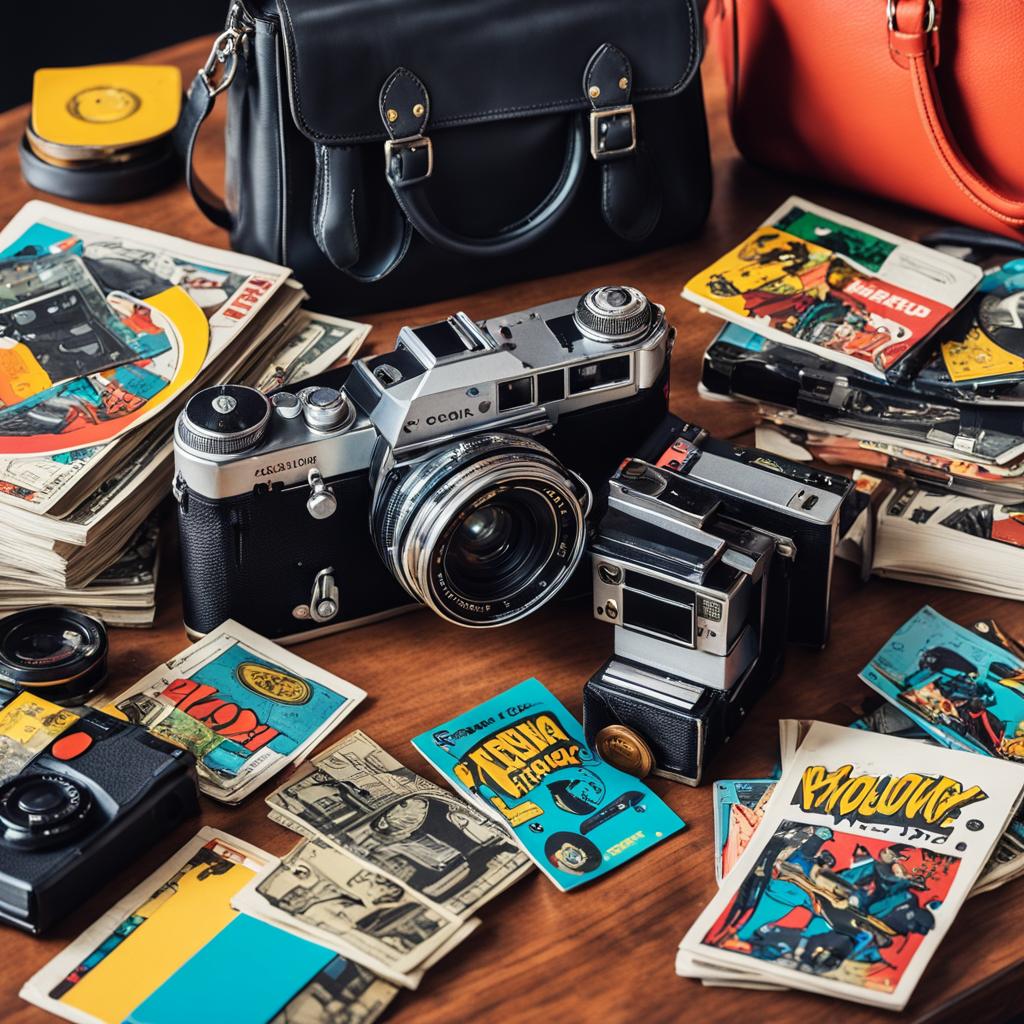Flipping items for profit has become a popular way to earn extra money on the side. Whether you’re looking to make $50 or $5000 a month, flipping can be a rewarding and lucrative venture. But with so many items to choose from, what are the best ones to flip for maximum profit?
In this article, I will guide you through the top items for flipping that can help you achieve your financial goals. Whether you’re a beginner or have some flipping experience, there are profitable items out there that can suit your skills and interests.
Key Takeaways:
- Flipping items can be a profitable part-time venture.
- There are various items you can flip for profit, from collectibles to furniture.
- Research and market demand play a crucial role in successful flipping.
- Choose items that have a high resale value to maximize your profits.
- Providing excellent customer service can help you build a loyal customer base.
Flipping 101
Welcome to Flipping 101, your beginner’s guide to the basics of flipping! If you’re looking to make some extra money on the side, flipping can be a profitable and rewarding endeavor. It involves the process of buying low-cost items and selling them for a higher price to make a profit. Whether you’re a stay-at-home parent, a college student, or simply looking for a new side hustle, flipping can be a great option to explore.
So, how do you start flipping? Let me walk you through the essential steps:
- Find items with potential value: Look for items that are in demand, have a higher resale value, or can be refurbished to increase their worth. Keep an eye out for popular trends and timeless classics.
- Refurbish or improve: If necessary, invest time and effort into refurbishing or improving the items you’ve acquired. This can involve cleaning, repairing, painting, or even upgrading the item to enhance its value.
- Sell for a higher price: After improving the item, it’s time to find a suitable platform or marketplace to sell it. Choose platforms based on the target audience and the type of item you’re selling. Popular options include online marketplaces like eBay, local classifieds like Craigslist, or even niche platforms focused on specific items.
Remember, success in flipping comes with experience and a sharp eye for value. It’s important to research the market, stay updated with current trends, and build a network of reliable suppliers and potential buyers.
Flipping allows you to turn your passion for bargain hunting into a profitable venture.
So go ahead and start exploring your local thrift stores, online marketplaces, and even garage sales. You never know what hidden gems you may come across that can fetch you a significant profit. With a bit of practice and perseverance, you’ll soon master the art of flipping and watch your side hustle turn into a lucrative business.
The Benefits of Flipping
Flipping offers several advantages, making it an attractive side hustle option:
- Flexible schedule: Flipping allows you to work at your own pace and on your own terms, giving you the freedom to choose when and how much you want to work.
- No initial investment: Unlike starting a traditional business, flipping doesn’t require a large upfront investment. You can start small and gradually reinvest your profits to grow your flipping business.
- Creative outlet: Flipping gives you the opportunity to explore your creativity and find innovative ways to enhance the value of items. It’s a chance to unleash your artistic side.
With the basics of flipping covered, let’s dive deeper into the pros and cons in the next section to help you make an informed decision about this rewarding side hustle.
Flipping Pros and Cons
Flipping items can be an exciting and rewarding venture, but like any business, it has its advantages and disadvantages. Understanding the pros and cons of flipping is crucial for making informed decisions and maximizing your success.
Advantages of Flipping
- Flexibility: One of the greatest advantages of flipping is the flexibility it offers. You have control over your schedule and can work on your own terms.
- Creative Outlet: Flipping allows you to unleash your creativity. You can transform old, neglected items into something beautiful and desirable.
- Low Initial Investment: Unlike many other businesses, flipping often requires little to no initial investment. You can start small and grow your inventory gradually.
Disadvantages of Flipping
- Time and Energy: Flipping requires time and energy to source, refurbish, and sell items. It’s not a passive income stream and demands active involvement.
- Imagination: To stand out in a competitive market, you need to think creatively and find unique ways to add value to the items you flip.
- Selling and Storage: Finding a reliable way to sell your items and storing them before they’re sold can be challenging. You’ll need to explore online platforms, local marketplaces, or your own website for selling opportunities.
“Flipping items can be an exciting and rewarding venture, but like any business, it has its advantages and disadvantages.”
Despite the challenges, flipping offers numerous benefits that can outweigh the drawbacks. With dedication, resourcefulness, and a keen eye for opportunities, you can turn flipping into a profitable and fulfilling endeavor.

| Advantages of Flipping | Disadvantages of Flipping |
|---|---|
| Flexibility | Time and Energy |
| Creative Outlet | Imagination |
| Low Initial Investment | Selling and Storage |
How Much Money Can I Make From Flipping?
When it comes to flipping items, the earning potential can vary greatly. It all depends on the time and effort you are willing to invest. Some individuals make a substantial income of up to $5,000 per month by flipping items regularly. These ambitious flippers dedicate significant time and energy to their endeavors, constantly searching for profitable items and putting in the necessary work to refurbish and resell them.
On the other hand, if you prefer a more casual approach to flipping, you can still generate a steady income. Even with a smaller time commitment, some individuals manage to make an extra $50 to $100 per month by flipping items in their spare time.
Real-Life Success Stories
Let me share a couple of real-life success stories to give you a better understanding of the income potential in the flipping business.
“My name is Emma, and I’ve been flipping items for about two years now. Initially, it started as a fun hobby, but soon I realized the income potential. I dedicated more time to my flipping business, and, on average, I make around $3,000 to $4,000 per month. It’s not only a great source of additional income but also something I genuinely enjoy. I love the thrill of finding undervalued items and turning them into profitable sales.”
“Hi everyone! I’m Mike, a part-time flipper. I work a day job, so flipping is my side hustle. I spend around 5 to 10 hours per week on it, and it brings me an extra $200 to $300 monthly. It’s not a massive income, but it definitely helps with my bills and allows me to save for future goals. Plus, it’s a rewarding way to spend my free time.”
As you can see from these examples, the earning potential of flipping is within reach for anyone. The more time and effort you invest, the higher your chances of making substantial profits. However, it’s important to note that flipping income can be unpredictable, as it depends on market demand and individual factors.
In the next section, we’ll explore the legality of flipping items, ensuring you have a clear understanding of the rules and regulations to operate your flipping business within legal boundaries.

Is Flipping Items Illegal?
Flipping items can be a profitable venture, but it’s essential to ensure that your activities remain within the bounds of the law. In most cases, flipping items is legal as long as you are transparent about the condition of the items and do not misrepresent them as new. However, it’s crucial to familiarize yourself with local laws and regulations, particularly when selling certain types of goods or using branded trademarks.
If you’re unsure about the legality of flipping certain items, it’s always a good idea to do some research or consult with legal professionals to ensure compliance. Additionally, selling a significant volume of goods may require obtaining permits, so it’s important to stay informed and meet any necessary requirements.
Remember, the key to successful flipping is operating within the boundaries of the law and maintaining transparency with potential buyers. By doing so, you can enjoy the profitability of flipping items while avoiding any legal issues that may arise.
“Selling over a certain amount of goods may require permits.”
To summarize:
- Flipping items is legal as long as you sell them as used and don’t misrepresent them as new.
- Research local laws and regulations pertaining to the sale of specific goods or the use of branded trademarks.
- Consult legal professionals if you’re unsure about the legality of flipping certain items.
- Be aware that selling a significant volume of goods may require permits.
By operating within the legal boundaries, you can enjoy the benefits of flipping items without any legal concerns.

Where to Find Things to Flip
When it comes to flipping items for profit, the first step is sourcing the right products. There are numerous places where you can find items to flip at affordable prices or even for free. Here are some of the best places to find flipping items:
- Your own house: Start by looking around your own home. You may be surprised to find items that you no longer need or use, but others might be interested in buying. Clothing, electronics, furniture, and home decor are just a few examples of things you might have tucked away.
- Friends and family: Don’t overlook the potential of your social network. Talk to friends, family members, and neighbors to see if they have any items they no longer want. They might be happy to give them to you for free or at a low cost.
- Garage sales: Garage sales can be a treasure trove of items to flip. People often sell things they no longer need at bargain prices. Visit local garage sales in your area and keep an eye out for items with high resale potential.
- Thrift stores: Thrift stores are a popular destination for resellers. These stores typically sell secondhand items at affordable prices, making them a great source for flipping items. Look for unique or high-quality items in good condition.
- Online platforms: The internet provides endless opportunities for sourcing items to flip. Websites like Craigslist and eBay are popular platforms where people sell used items. These platforms often have a wide range of products available, giving you plenty of options to choose from.
- Dumpster diving (if legal in your area): Dumpster diving can be a controversial but potentially lucrative way to find free items to flip. Before diving in, make sure to research local laws and regulations regarding dumpster diving.
Remember, the key to successful flipping is finding items with resale value. Keep an open mind and be willing to put in the effort to source quality items. The more diverse your sourcing channels, the better your chances of finding profitable flipping items.
“The treasure you seek might just be hiding in plain sight, waiting to be discovered and flipped for a profit.” – Flip with Me
Popular Platforms to Flip Items
When it comes to selling flipped items, there are several popular platforms to choose from. These platforms provide a wide reach and attract potential buyers who are specifically interested in flipping items. Whether you’re selling refurbished furniture, collectible toys, or vintage clothing, these platforms can help you reach your target audience and maximize your sales.
Here are some of the best platforms for flipping:
- Facebook Marketplace: With its large user base, Facebook Marketplace is a great platform to sell a variety of flipped items. You can create listings, interact with potential buyers, and negotiate prices.
- Craigslist: Craigslist is a classified advertisements website where you can list your flipped items for free. It’s a popular platform for selling locally, which can be advantageous if you’re selling larger items.
- eBay: Known for its extensive reach, eBay allows you to sell a wide range of items, including those that are popular for flipping. You can set auction-style listings or fixed-price listings to attract potential buyers.
- Amazon Seller: If you’re flipping brand-new items, Amazon Seller can be a great platform to reach a wide audience of online shoppers. However, keep in mind that selling on Amazon requires meeting certain requirements and paying fees.
- Etsy: If you specialize in flipping vintage or handmade items, Etsy is the perfect platform for you. It caters to a niche market of buyers interested in unique and one-of-a-kind products.
- Your own personal website: Setting up your own website gives you full control over your sales channel. You can showcase your flipped items, provide detailed descriptions, and offer a seamless buying experience.
Choosing the right platform depends on various factors, such as the type of items you’re selling, your target audience, and your personal preferences. Consider your specific needs when deciding which platforms to use for selling your flipping items. You may also choose to utilize multiple platforms to diversify your reach and increase your chances of making successful sales.

Successful flipping items
When it comes to flipping items for profit, there are a few key things to keep in mind in order to be successful. First and foremost, you need to know what the best things to flip for money are. This can vary depending on the current market conditions, but there are definitely some items that are almost always profitable to flip.
Some of the best things to flip for money right now include furniture, vintage items, and electronics. These items are all relatively easy to find and usually sell for a decent profit. Of course, you always want to do your own research before buying anything to flip, as you don’t want to overspend on an item that won’t sell.
Once you’ve found a few good items to flip, the next step is to price them correctly. This is where a lot of people make mistakes, as they either underprice their items and don’t make enough money, or overprice them and don’t sell anything. Again, doing your research is key here. Look at similar items that have sold recently and price yours accordingly. Successful flipping items of high-demand flipping items is tricky but you can always flip items for profit!
Finally, once you’ve priced your items correctly, it’s time to list them for sale. There are a number of different platforms you can use to do this, but some of the most popular are Facebook Marketplace, eBay, and Craigslist. take the time to create good listings with plenty of photos and detailed descriptions, as this will help increase your chances of making a sale.
So, there you have it! These are just a few tips to help you be successful when flipping items for profit. Remember to do your research, price your items correctly, and create good listings, and you should be well on your way to making some extra money.
Best Items to Resell for Profit
In the world of flipping, selecting the right items to resell can significantly impact your profitability. To maximize your earnings, it’s crucial to focus on items with a high resale value. After conducting extensive market research, I have identified several categories of items that consistently yield high profits when resold.
Rare and Collectible Items
One of the most lucrative niches in the flipping world is rare and collectible items. These can include limited-edition art pieces, vintage jewelry, autographed memorabilia, or antique collectibles. The scarcity and uniqueness of these items make them highly sought after by collectors, driving up their market value.
Vintage Furniture and Clothing
Vintage furniture and clothing items hold tremendous potential for reselling at a significant profit. Pieces with unique designs, historical significance, or recognizable brand names are particularly desirable. Restoring and refurbishing these items can help enhance their appeal and increase their resale value.
Broken or Non-Functional Items that Can Be Repaired
Items that are broken or non-functional may seem like a lost cause to some, but for savvy flippers, they represent an opportunity. Repairing these items and bringing them back to working condition can add significant value. Examples include broken electronics, appliances, or even vintage cars that can be restored to their former glory.
Collectible Toys or Games
The market for collectible toys and games continues to grow, presenting a profitable avenue for resellers. Limited-edition action figures, vintage board games, or rare trading cards can command substantial prices. Keeping an eye out for popular trends and nostalgia-inducing items can help you strike gold in this category.
To illustrate the potential profitability of these items, take a look at the following table showcasing estimated average profit margins:
| Item Category | Estimated Profit Margin |
|---|---|
| Rare and Collectible Items | $300 – $5000+ |
| Vintage Furniture and Clothing | $100 – $2000+ |
| Broken or Non-Functional Items that Can Be Repaired | $50 – $1000+ |
| Collectible Toys or Games | $50 – $500+ |
These estimates are not exhaustive and can vary depending on various factors such as item condition, rarity, age, and market demand. Conducting thorough research within your niche can help refine your understanding of profit potential further.
By strategically targeting these high-profit flipping items, you can greatly increase your chances of success in the reselling market. Remember to always stay informed about market trends, make smart purchasing decisions, and provide excellent value to your customers.
Easiest Items to Flip for Cash
If you’re looking to make quick cash through flipping, there are several beginner-friendly items that can be relatively easy to flip. These quick flips for profit can help you get started on your flipping journey. Here are some of the easiest items to flip for cash:
Furniture that can be refurbished
If you have a knack for DIY projects, refurbishing furniture can be a profitable venture. Look for second-hand furniture pieces that are in good structural condition but may need some love. With a fresh coat of paint, new upholstery, or simple repairs, you can transform these items into desirable pieces and sell them for a higher price.
Specialty items like blenders or ice cream machines
Specialty kitchen appliances like blenders or ice cream machines can be popular items to flip. Look for gently used or discounted items from retailers, as well as online marketplaces. These items are often in demand, especially during certain seasons, and can fetch a good price when resold.
Used clothing sold on platforms like ThredUp or Poshmark
Platforms like ThredUp and Poshmark offer a convenient way to buy and sell used clothing. You can find high-quality, fashionable clothing items at affordable prices and resell them for a profit. Keep an eye out for popular brands or unique pieces that have a good resale value.
Used equipment and tools from garage sales or thrift stores
Garage sales and thrift stores can be treasure troves for finding used equipment and tools at bargain prices. Look for items that are still in good working condition but can be resold at a higher price. Common examples include power tools, gardening equipment, or kitchen appliances.
Vintage record players or video game consoles
Vintage electronics like record players or video game consoles can be highly sought after by collectors and enthusiasts. Look for well-maintained vintage items that are in demand, and ensure they are in good working condition before purchasing. With the right buyer, these items can fetch a good price.
Remember, when flipping these items, it’s important to do your research and ensure there is a market demand for them. Additionally, consider the condition, cost of repairs (if any), and potential resale value before making a purchase. By focusing on these beginner-friendly flipping items, you can start making some quick cash and gain valuable experience in the flipping world!
“Flipping furniture and specialty items like blenders or ice cream machines are some of the easiest items to flip for quick cash. By refurbishing furniture or finding in-demand specialty appliances, you can turn a profit in no time.”
7 Tips for Successful Flipping
Successful flipping requires careful planning and execution. Here are seven tips to help you succeed:
- Research and identify profitable items to flip: Conduct thorough market research to identify items that have a high demand and can be sold at a profitable price. Look for trends, popular brands, and niche markets to target.
- Set a budget and stick to it: Determine how much capital you’re willing to invest in your flipping venture and establish a budget for acquiring inventory, transportation, repairs, and marketing. Sticking to your budget will help ensure profitability.
- Improve your negotiation skills: Negotiation plays a crucial role in acquiring items at the lowest possible cost. Hone your negotiation skills by researching market prices, being confident, and finding potential sellers who are open to bargaining.
- Learn basic repair and refurbishment techniques: Being able to repair and refurbish items can significantly increase their value and profit potential. Invest time in learning basic repair skills or partner with professionals who can help you enhance the condition of your items.
- Build a network of reliable suppliers: Establish connections with reliable suppliers who can provide you with high-quality items at competitive prices. Attend trade shows, join online communities, and cultivate relationships with wholesalers or manufacturers.
- Price your items competitively: Research the market and analyze the prices of similar items to ensure that your pricing is competitive. Consider factors such as the item’s condition, rarity, and demand when setting your prices.
- Provide excellent customer service: Customer satisfaction is key to building a successful flipping business. Offer prompt communication, accurate item descriptions, fast shipping, and hassle-free returns to establish a positive reputation and gain repeat customers.
By following these tips, you’ll be well-equipped to navigate the world of flipping and increase your chances of success. Happy flipping!
The Bottom Line on Best Items to Flip for Money
Flipping items can be a profitable part-time hustle, with the potential to earn anywhere from $50 to $5000 a month depending on your efforts. The key to successful flipping lies in focusing on the best items that have high resale value. Here’s a roundup of the top items to flip for money.
Rare and Collectible Items
If you have an eye for valuable and hard-to-find items, flipping rare and collectible items can be highly lucrative. These can include vintage coins, stamps, limited edition art prints, antique jewelry, or even specialty items like sports memorabilia.
Vintage Furniture and Clothing
There is a growing market for vintage furniture and clothing, as many people appreciate the unique style and craftsmanship of bygone eras. Look for well-preserved pieces that showcase timeless designs, and consider refinishing or reupholstering them to increase their appeal and value.
Broken or Non-Functional Items
Don’t underestimate the potential of broken or non-functional items. If you have the skills to repair them, these items can be purchased at a low price and resold at a significantly higher value. Some examples include electronics, small appliances, or even vintage cars that need a little love and attention.
Popular Toys or Games
Children’s toys and games that are highly sought-after by collectors or enthusiasts can be great items to flip. Look for discontinued or limited edition items, such as vintage Lego sets, rare Pokémon cards, or popular board games from the past.
To maximize your profits in flipping, do thorough research on market trends and demand. Consider your target audience and their preferences. Providing excellent customer service and ensuring your items are accurately represented will help establish a positive reputation and attract repeat buyers.
| Best Items to Flip for Money | Price Range |
|---|---|
| Rare and Collectible Items | Varies, can range from $100 to thousands of dollars |
| Vintage Furniture and Clothing | Varies, can range from $50 to several hundred dollars |
| Broken or Non-Functional Items | Varies, can range from $10 to a few hundred dollars |
| Popular Toys or Games | Varies, can range from $20 to a few hundred dollars |
Remember, the key to successful flipping is finding items that have high demand and are in good condition. By focusing on these best items to flip for money, you can increase your chances of making substantial profits and turning your part-time gig into a successful venture.
Flipping Houses as a Wise Investment
When it comes to real estate investment, flipping houses can be a smart and profitable choice. With the potential to earn substantial returns, flipping houses attracts both seasoned investors and those looking for a side hustle. However, it’s important to understand the ins and outs of house flipping before diving in.
According to recent data, the average profit on a house flip in 2024 was $73,766. This indicates a lucrative market with the potential for significant financial gain. Furthermore, with house prices expected to rise in 2024, now may be an opportune time to invest in house flipping.
Flipping houses offers the flexibility to be pursued as a part-time endeavor or a full-time career. Whether you’re a beginner or an experienced investor, house flipping can provide a steady income stream and offer the satisfaction of transforming a property into something desirable.
However, it’s essential to recognize the risks involved in flipping houses. Unexpected expenses, such as repairs, renovations, or legal issues, can eat into your profits. Additionally, house flipping requires an initial investment of capital, which may pose a challenge for some individuals.
Ultimately, flipping houses can be a wise investment if approached with caution and careful planning. Conduct thorough research, create a realistic budget, and seek professional advice to navigate the complexities of the real estate market. By doing so, you can increase your chances of success and profitability in the world of house flipping.
Good and Bad Sides of Flipping Houses
When it comes to flipping houses, there are both advantages and disadvantages to consider. Let’s explore the pros and cons of house flipping, so you can better understand if it’s the right investment strategy for you.
Advantages of House Flipping
- Potential for Decent Returns: One of the biggest advantages of flipping houses is the potential to make significant profits. By buying properties at a lower price, making improvements, and selling at a higher price, you can earn a substantial return on your investment.
- Flexibility as a Side Hustle: Flipping houses can be done part-time, allowing you the flexibility to pursue other interests or maintain a full-time job. This makes it an attractive option for those looking to generate additional income without committing to it full-time.
- Rehabilitating Homes: Flipping houses can be a fulfilling endeavor as it gives you the opportunity to breathe new life into neglected properties. By renovating and improving the condition of houses, you contribute to the revitalization of neighborhoods and provide buyers with a more desirable living space.
Disadvantages of House Flipping
- Uncertainty in Selling Flipped Homes: One of the risks of house flipping is the potential difficulty in selling a flipped property. Market conditions, location, and competition can all impact the speed and price at which you’re able to sell the house, posing a challenge to your profitability.
- High Upfront Costs: House flipping requires substantial upfront costs. From purchasing the property and covering renovation expenses to property taxes, insurance, and carrying costs, you need a considerable amount of capital to get started. Managing cash flow and budgeting effectively are crucial to the success of your house flipping venture.
As with any investment, house flipping comes with its fair share of risks and rewards. It’s essential to weigh the pros and cons before diving into this venture. Consider your financial situation, skills, and local market conditions to make an informed decision about whether house flipping aligns with your goals and aspirations.
Now that we’ve examined the good and bad sides of flipping houses, let’s take a closer look at the amount of money you can potentially make from house flipping in the next section.
Conclusion
In conclusion, flipping items can be a lucrative part-time venture that has the potential to earn you significant profits. By focusing on the best items to flip, sourcing them from various places, and utilizing popular platforms for selling, you can maximize your chances of success.
However, it’s important to be aware of the risks and challenges involved in flipping. Unexpected expenses and market fluctuations can pose obstacles along the way. It’s crucial to approach flipping with a strategic mindset, always prepared for potential setbacks.
With the right strategies and dedication, flipping can be a rewarding and profitable endeavor. Remember to research and identify profitable items, set a budget, improve your negotiation skills, and provide excellent customer service. By implementing these tips, you can increase your chances of success in the flipping business.
FAQ
What is flipping?
Flipping is the act of buying low-cost items and selling them for a profit.
How much money can I make from flipping?
The amount of money you can make from flipping items varies depending on the time and effort you put into it. Some people make up to $5,000 a month by flipping items regularly, while others make $50 to $100 a month with a more casual approach.
Is flipping items illegal?
Flipping items is legal as long as you’re selling them as used and not misrepresenting them as new. However, it’s important to research local laws and regulations, especially when selling certain types of goods or using branded trademarks. Selling over a certain amount of goods may require permits.
Where can I find things to flip?
You can find things to flip at affordable prices or even for free in your own house, from friends and family, at garage sales, thrift stores, online platforms like Craigslist or eBay, and even through dumpster diving (if legal in your area).
What are the best platforms to sell flipped items?
Some of the best platforms to sell flipped items include Facebook Marketplace, Craigslist, eBay, Amazon Seller, Etsy, and your own personal website. The choice of platform depends on the type of items you’re selling and your target audience.
What are the best items to flip for profit?
The best items to flip for profit include rare and collectible items, vintage furniture and clothing, broken or non-functional items that can be repaired, and collectible toys or games. Doing market research can help you identify the best items for your niche.
What are the easiest items to flip for quick cash?
Some of the easiest items to flip for quick cash include furniture that can be refurbished, specialty items like blenders or ice cream machines, used clothing sold on platforms like ThredUp or Poshmark, used equipment and tools from garage sales or thrift stores, and vintage record players or video game consoles.
What are some tips for successful flipping?
Some tips for successful flipping include researching and identifying profitable items to flip, setting a budget and sticking to it, improving your negotiation skills, learning basic repair and refurbishment techniques, building a network of reliable suppliers, pricing your items competitively, and providing excellent customer service.
How can flipping houses be a wise investment?
Flipping houses can be a wise investment because it allows you to make decent returns, provides the flexibility to do it as a side hustle, and can be rewarding in terms of rehabilitating a home. However, it also comes with risks such as potential unexpected expenses and the need for initial capital.
What are the good and bad sides of flipping houses?
The good sides of flipping houses include the ability to make decent returns, the flexibility to do it as a side hustle, and the rewarding feeling of rehabilitating a home. The bad sides include the risk of not being able to sell a flipped house and the high upfront costs involved in starting a house flipping business.
Our Friends
- https://premierrealestate.pro/blog/why-flipping-houses-in-2024-is-a-wise-investment/
- https://millennialmoneyman.com/best-items-to-flip/
Money posts:
 Best Items to Flip Part-Time ($50-5000 A Month!) (2024)
Best Items to Flip Part-Time ($50-5000 A Month!) (2024)
 How to Flip Houses – A Guide for New Real Estate Investors
How to Flip Houses – A Guide for New Real Estate Investors
 The Best Books on Flipping Houses (2024)
The Best Books on Flipping Houses (2024)
 23 Best Places To Sell Used Furniture & Make Money Fast! (2024)
23 Best Places To Sell Used Furniture & Make Money Fast! (2024)
 What to Look For at Garage Sales (To Make Actual Money)
What to Look For at Garage Sales (To Make Actual Money)
 The Profit First Method | Will it Really Keep Your Business Sustainable and Profitable? | 2024
The Profit First Method | Will it Really Keep Your Business Sustainable and Profitable? | 2024
 The Ultimate Rolex Buying Guide (2024)
The Ultimate Rolex Buying Guide (2024)
 How To Invest In Real Estate (2024)
How To Invest In Real Estate (2024)

